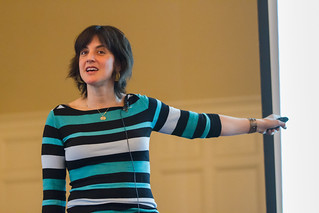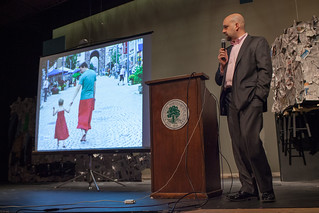“I’ve never met a girl who doesn’t have something to be sorry about,” said Rachel Simmons to her female audience on April 12. “It’s not, ‘people were so mean to me and now I’m so nice.’ No one’s perfect.”
 On April 12, Ms. Simmons, a nationally regarded speaker on bullying prevention and female empowerment, spoke to the girls of the Williston Northampton School about how they could identify hurtful behavior, and change the patterns that created it.
On April 12, Ms. Simmons, a nationally regarded speaker on bullying prevention and female empowerment, spoke to the girls of the Williston Northampton School about how they could identify hurtful behavior, and change the patterns that created it.
The Upper School had divided in two for the special morning assembly. Girls listened to Ms. Simmons in the Phillips Stevens Chapel, while boys headed to the Williston Theatre to hear Dr. Christopher Overtree, director of the Psychological Services Center (PSC) at the University of Massachusetts at Amherst and an expert on the prevention of bullying and harassment.
In the Chapel, Ms. Simmons talked about what she called “relational aggression,” an attitude she described as “if you don’t do what I want, I won’t be friends with you anymore.”
“A good friend doesn’t threaten the friendship,” she said. “In a healthy relationship, you should feel comfortable sharing your feelings.”
Part of the ongoing problem girls have with relationships stems from the fallacy of the “good girl,” an uber-perfect creature who was perfectly groomed and always on good terms with those around her, Ms. Simmons said.
“We’re expected to hold ourselves in, not just physically, but in the way we act,” she said.
 As a result, girls were expected to ignore, or even laugh at, rude statements that ended with “just kidding!” But not all jokes were funny, Ms. Simmons said. She encouraged girls to use a “no joke zone” or NJZ, where one person could ask her friends to take a sensitive topic — age, weight, family, hair, appearance — off the table.
As a result, girls were expected to ignore, or even laugh at, rude statements that ended with “just kidding!” But not all jokes were funny, Ms. Simmons said. She encouraged girls to use a “no joke zone” or NJZ, where one person could ask her friends to take a sensitive topic — age, weight, family, hair, appearance — off the table.
“Your NJZ could be your friends, family, racial background,” Ms. Simmons said. “If you say, ‘That’s my NJZ,’ the other person has to apologize, sincerely. Then you talk about something else. It’s a low-drama tool.”
While Ms. Simmons encouraged girls to speak openly and honestly about their needs and feelings, she noted that the way they asked also mattered. Rather than being aggressive (asking for what they needed in a way that was hurtful or offensive), or passive (dropping hints and assuming the other person would guess the right answer), Ms. Simmons suggested they be assertive and pose their questions or statements in a way that intended no hurt or disrespect.
“You have to look at what I’m talking about as something you have to learn and practice,” Ms. Simmons said. “Your friendships right now are the classroom for you to develop the skills you’ll use later on.”
Do the Clothes Make the Man?
In the theater, Dr. Overtree spoke to Williston Northampton’s boys about the ways in which conscious and subconscious thoughts and attitudes dictate our actions.
 The age-old concept of “breaking out of the mold” is one that Dr. Overtree simultaneously likes and dislikes. He likes the idea of standing up for your true self, but he doesn’t believe this confining mold exists. “We create it through our behavior and our attitude,” he explained.
The age-old concept of “breaking out of the mold” is one that Dr. Overtree simultaneously likes and dislikes. He likes the idea of standing up for your true self, but he doesn’t believe this confining mold exists. “We create it through our behavior and our attitude,” he explained.
Throughout his talk, Dr. Overtree repeatedly returned to a photo of what looked like a man in a skirt walking down the street with his daughter. Dr. Overtree explained that it was a photo of a German man, Nils Pickert, and his son in a dress. Mr. Pickert’s son had wanted to wear what is conventionally thought of as women’s clothing. Rather than try to convince his son to only wear dresses at home, Mr. Pickert decided to support his son.
“The only courageous thing he could do was wear a dress with his son,” said Dr. Overtree. The best course to take, he added, is to respect others when they “break out” of the mold.
Read senior Mairead Poulin’s article for The Willistonian, “Good Girls, Bad Friends.”

